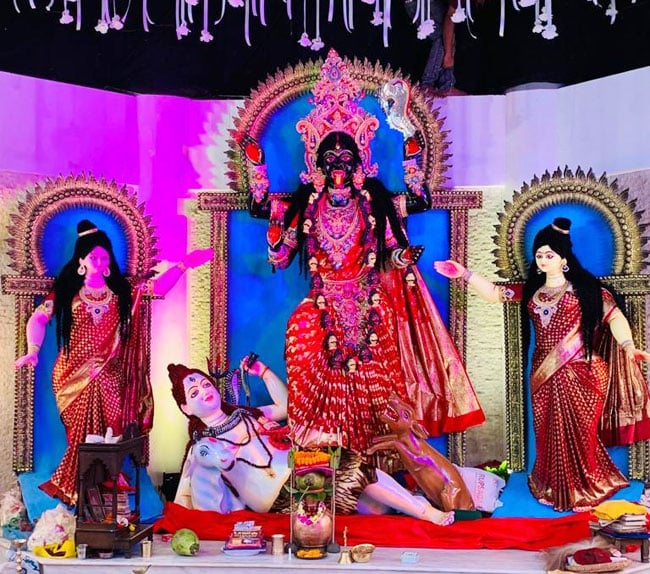
DHAKA, Nov 13, 2023 (BSS) - Kali Puja or Shyama Puja, the second largest festival after Durga Puja of Bangalee Hindu community, was celebrated countrywide last night and in the early hours of today with worshiping goddess Kali, lighting earthen lamps, candles at temples and residences amid due religious fervor and enthusiasm.
Kali Puja is also called Deepabali or Diwali, the festival of lights.
Kali Puja, worshipping the Goddess of strength, wisdom and enlightenment, is celebrated at the night of Amavasya of the Bangla month of Kartik (October or November).
Amavasya Tithi started at 02:45 pm on Sunday and it ended at 02:57 am today. Offering of puja to Goddess Kali started at temples from 10 pm followed by offering of Anjali and distribution of prashad.
Marking the festival, members of the Hindu community lit up earthen lamps (Pradeep) at their houses, temples and crematoriums in memory of their departed elderly persons.
In the capital city, Shyama Puja celebration was held at Dhakeshwari National Temple, Siddheshwari Kali Temple, Ramna Kali Mandir, Sri Sri Baradeshwari Kalimata Temple under Sabujbagh police station, Radha Gobinda Jeo's Thakur Temple at Banagram, Postogola crematorium, Ramkrishna Mission, Biharilal Jeo's Temple at Sutrapur, Gautam Mandir, Ramseeta Mandir, Shibmandir at Shankharibazar, Tanti Bazar and Bangla Bazar.
At Dhakeshwari National Temple, worshiping of Goddess Kali began at 10 pm followed by offering Anjali by a large number of devotees who kept fasting all the day after taking dinner on Saturday, Later, charanamrito and maha prashad were distributed among devotees, said Monindra Kumar Nath, president of Mahanagar Sarbajanin Puja Committee.
Earlier the festival began with lighting up 1,000 earthen lamps on the temple premises as Principal and Secretary of Ramkrishna Math and Ramkrishna Mission, Dhaka Smt. Swami Purnatmanandaji Maharaj inaugurated it in the evening.
Later, devotional songs were performed on the temple premises by noted singers.
Talking to BSS, Ramna Kali Mandir managing committee president Utpal Saha said Kali puja celebration began with lighting up earthen lamps and candles on the temple premises on Sunday evening.
Worshiping of the goddess Kali began at 12.15 am today (Monday) with chanting mantras. Later Anjali was offered to Devi Kali by a massive number of devotees who kept fasting on that day followed by distribution of charanamrito at 4am.
Later, 108 earthen lamps were lit up in front of Devi Kali which is called Deepabali. Later, animals were sacrificed on the temple premises at 4.30am. Maha prashad were distributed among devotees at 5 am.
At Siddheshwari Kali Mata temple, celebration began with lighting up lamps on the temple premises as State Minister for Cultural Affairs KM Khalid inaugurated it. Later, he joined a view exchange meeting with Hindu community members on the temple premises.
Since evening, Dhakeshwari National Temple, Ramna Kali temple, Siddheshwari Kali Mata Temple and Jagannath Hall Upasanaloy saw a massive number of crowds as devotees were seen lighting up candles and earthen lamps.
Youths and children were seen burst firecrackers like tarabaji and kali potka all the night making the festival more vibrant while fire-works also took place in some temples including Ramna Kali Temple and Jagannath Hall Upasanalay on Dhaka University campus and temples in old part of Dhaka.
Likewise previous years, the largest Kali Puja celebration is taking place in Shakhari Bazar, Tanti Bazar in the old part of the city and Mymensingh and Jashore where pandals are kept for four to six days.
Makeshift temples and mandaps in Shakhari Bazar and Tanti Bazar were decorated and illuminated gorgeously.
One day before Kali Puja falls the night of the deads, Bhoot Chaturdashi.
People believe that on this day, scary ghosts and spirits wander around the earth. The Bengalis celebrate their version of Halloween by lighting 14 earthen lamps and eating choddo shaak (14 greens).
These candles are lit to show lights to 14 forefathers and wander off the evil spirit. The popular belief is that on this day, our ancestors remain nearby and give blessings. Many also believe that the number of lamps represents 14 forefathers.
Another popular belief is that if fourteen earthen-lamps are lit at different entrances and dark corners of the rooms, then Chamunda (a fearsome aspect of Kali) along with fourteen other ghostly forms ward off the dark spirits from the house.
On Bhoot Chaturdashi, Bengalis consume a dish of Choddo Shaak which means 14 types of greens, so that evil spirits cannot possess the body.
In old texts, it is written that Kartik month (the Bengali pre-winter month) is the time when Yamraj (the god of death) becomes powerful, and all the eight gates to his kingdom remain open.
Bhoot Chaturdashi occurs on the 14th day of Krishna paksha (lunar phase) on the Hindu calendar month Karthik (October-November).
Probably that is why number fourteen is given importance in the rituals.
This time frame of 15 days from Kojagori Laxmi Puja to Kali Puja is considered inauspicious, as it is the waning phase of the moon.
On the eve of Kali Puja, Bengali families lit up fourteen earthen oil lamps (Diya) in the darkest corner around their houses. It is believed that fourteen of our ancestors come back to the household on this night to visit their dear ones, and these lamps help them find their loving homes and chase away the dark spirits.
According to Hindu texts, goddess Kali was born out of the brow of Goddess Durga during one of her battles with demons.
During the battle, Kali was so much in a killing spree that she began destroying everything that came in her sight. To stop her, Lord Shiva threw himself under her feet. Shocked by this, Kali stuck out her tongue in astonishment and put an end to her rampage.
The main purpose of the puja is to seek the help of the goddess in destroying evil-both in the outside world and within human being.